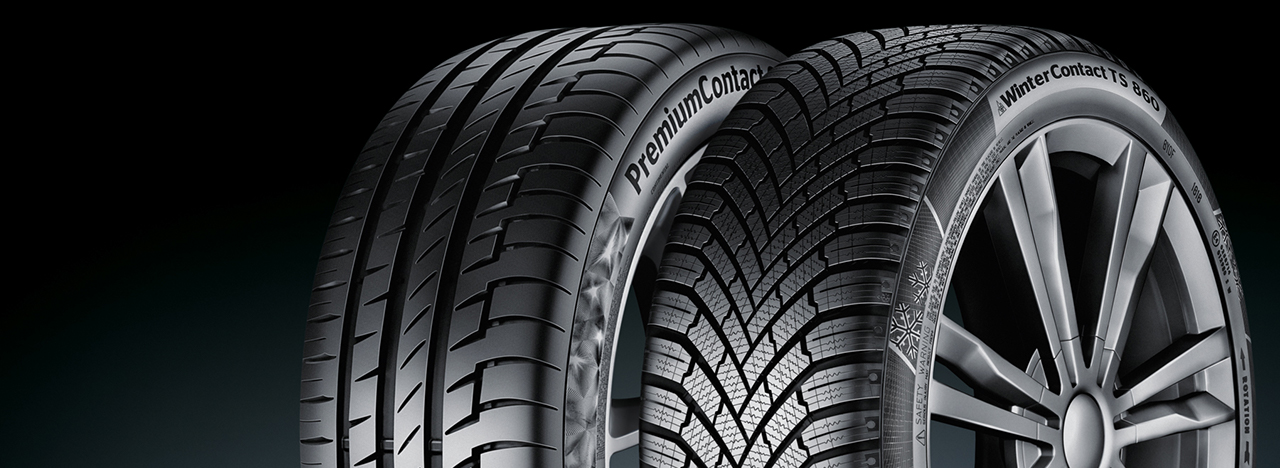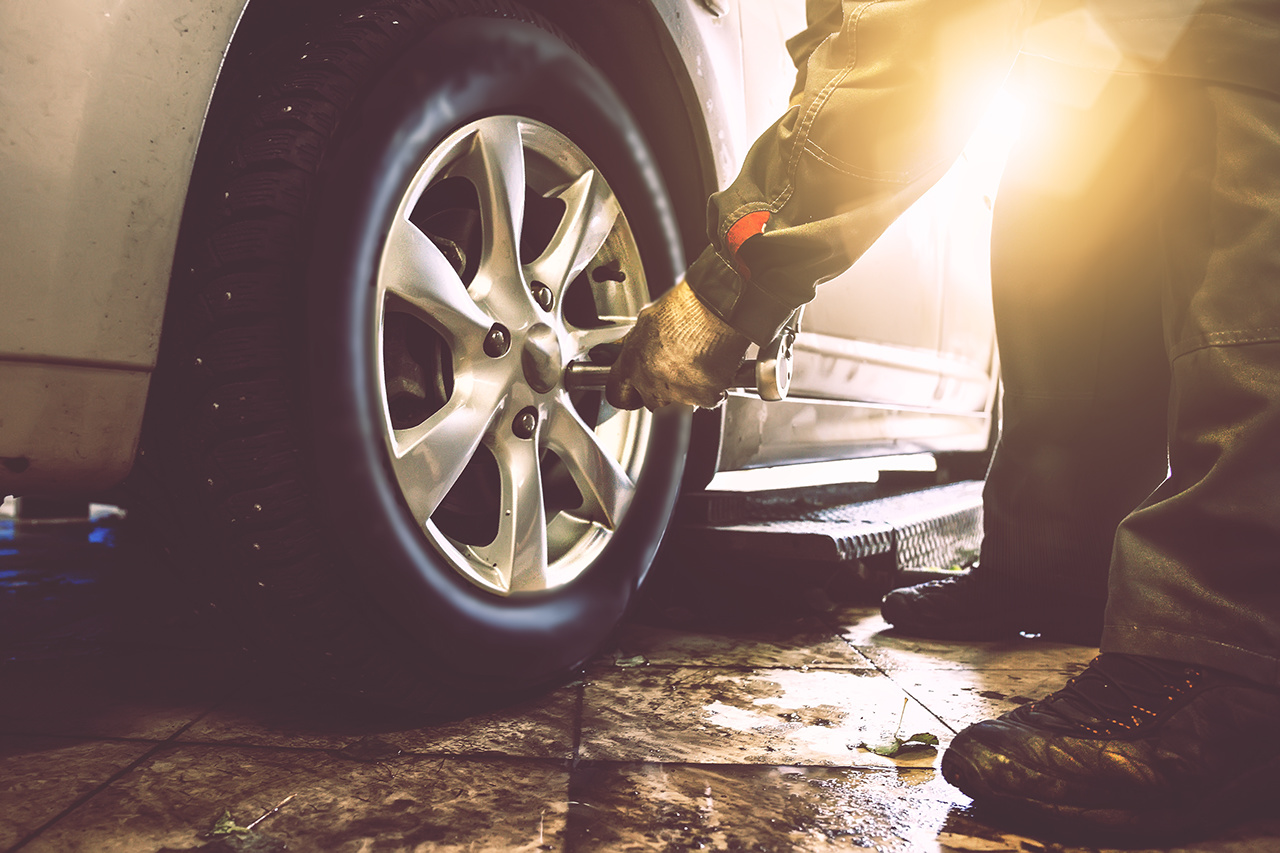
# Tyre Change and Fitting
How to change a tyre
An emergency puncture situation? Here’s your guide to changing a tyre.
There are several main reasons why drivers may need to exchange complete wheels on their vehicle:
- It’s time for a seasonal switch, i.e. from summer tyres to winter tyres, or vice versa.
- They’re damaged or showing tread wear. Check the tread wear indicator to find out if this is the case.
- They’re 10+ years old. Information provided on the sidewall details the age of a tyre. After this length of time, it’s a good idea to replace them – regardless of their condition. Vehicle manufacturers may recommend a different lifespan based on the specific vehicle application – adhere to this.
- You got a puncture while driving.
If you need to replace your tyres due to reasons 2 or 3, be sure to check your car’s spare tyre for damage or ageing at the same time. Replace it with a new one if needs be.
No matter the reason for a tyre change, how it’s done is fairly straightforward. Armed with some basic tools and our step-by-step guide, vehicle owners can properly manage this essential task themselves.
Let’s get started
1. Safety first: do these things before you begin.
- Park your car on a flat surface – never change tyres on a slope.
- Apply the hand brake and put the vehicle in park (if automatic) or in gear (if manual).
- Ensure no one is in the vehicle.
- Use chocks, or heavy objects (wedges of wood, bricks, large rocks) either side of the wheel diagonally opposite the one being changed.
- If you’re out driving and you get a flat, stop in a safe place well off the road, and turn on your car’s hazard lights.
2. Remove the hubcap or wheel cover if there is one.

3. Loosen – but don’t remove – the wheel nuts using a wheel wrench.
You only want to loosen them enough to make their removal easier once you’ve lifted the car off the ground. Wheel nuts too tight? You can carefully apply pressure to the wrench – ensuring it’s in a horizontal position – with your foot.
4. Raise the car up.
Place a jack under the car. If you’re not sure where, your car’s manual will let you know the right position to place the jack. Slowly and smoothly raise your car until the wheel to be changed is about 15 cm off the ground.
5. Remove your lug nuts.
Now that they have been loosened (step #3), you can remove them completely by hand. Make sure you put them in a safe place!
6. Remove your wheel.
Pull it towards you with both hands. Roll it away to the side and out of the way.
Important: If you’re in the process of switching out a complete set of tyres and you’re going to store them, label each one with a piece of chalk as you remove it. Think: LF (left front), RF (right front), and so on. Why? This way, you can keep track of where each one was mounted, and take this into account if you’re considering tyre rotation when you put them back on in future.

7. Replace the tyre.
Changing to a spare in an emergency puncture situation? Using both hands, lift your temporary spare wheel into place on the wheel bolts.
Seasonal tyre switch? If your tyres were marked with their position after last season (see 6), this will inform you of the tyre rotation position for each to ensure correct alignment and balance for your car. Roll each one to the correct wheel hub and lift onto the wheel bolts with both hands.
8. Tighten your wheel nuts.
Only do this by hand at first. Nuts should always be tightened one after the other in a diagonally opposite sequence, i.e. tighten one first, then tighten the one diagonally opposite it – not directly next to it.
9. Lower the vehicle and further tighten the wheel nuts with your wrench.
Again, as when you loosened the nuts, you can carefully apply extra pressure to the horizontally positioned wheel wrench with your foot as you tighten them. Normally, a torque wrench should be used with correct force, otherwise you might damage the bolts through elongation.
10. Refit the hubcap or wheel cover.
I’ve just changed my flat tyre. Can’t I just leave the spare tyre on my car?
No. Temporary spares are usually a different tyre size. They are lighter, smaller and don’t have the same speed or mileage capabilities as a permanent tyre. This could affect your vehicle’s stability when driving. However, the exception to this is if your spare is a full-sized match of the others on your vehicle.
Which leads us to...
11. Have you changed out a flat?
Put the punctured tyre in your boot and take it to a tyre professional for repair or replacement with a full-sized, permanent tyre.
Feeling unsure? Lacking the necessary equipment? Don’t hesitate to seek help from a tyre professional. They’ll be able to change that punctured tyre – or switch your seasonal tyres over – with complete confidence. Tip: while they’re at it, be sure to ask them to complete a full inspection of all your tyres – including your spare.
Related content
-
 2025/07/29The weather changes throughout the year, which affects driving conditions on the road; fit your car with tyres that will provide you with the most confidence.Summer tyres vs. winter tyresRead more
2025/07/29The weather changes throughout the year, which affects driving conditions on the road; fit your car with tyres that will provide you with the most confidence.Summer tyres vs. winter tyresRead more -
 2025/07/29Winter tyres are the undisputed champion when it comes to colder climates, but their unique features are a disadvantage if used in warmer temperatures.Winter tyres in summerRead more
2025/07/29Winter tyres are the undisputed champion when it comes to colder climates, but their unique features are a disadvantage if used in warmer temperatures.Winter tyres in summerRead more -
 2025/07/29Winter is a time to put winter tyres on your car. We recommend against using summer tyres if there's any snow, ice, or the temperature is freezing.Summer tyres in winterRead more
2025/07/29Winter is a time to put winter tyres on your car. We recommend against using summer tyres if there's any snow, ice, or the temperature is freezing.Summer tyres in winterRead more